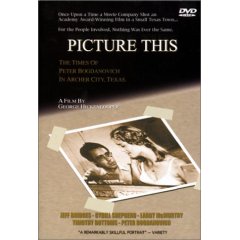
Filmed in Archer City, Texas
Before director George Hickenlooper completes production of the new Edie Sedgwick biop, it’s worth revisiting his earlier work. For now, I’ll focus on his touching and insightful documentary shot on location during the filming of Texasville (1990) -- which was itself a sequel to The Last Picture Show (1971), and based, like the earlier film, on a Larry McMurtry novel of the same name.
Picture This: The Times of Peter Bogdanovich in Archer City, Texas (1991) was produced by Timothy Bottoms and co-produced by Sam Bottoms, his brother.
The viewer quickly gets a feel for Archer City in any of these three films. In Hickenlooper’s work, the people from the community who were willing to talk are fascinating – defiantly rural in outlook but quite cognizant of pop culture. They are quite happy to make their attitudes known on film.
In Picture This, we learn a lot about the making of The Last Picture Show, directed (as was Texasville) by Bogdanovich. Production designer Polly Pratt, his wife at the time, had recommended making the book into a movie. Once they decided to do it in collaboration with Larry McMurtry, they flew to Dallas-Fort Worth and drove with him for two hours scouting locations before arriving in Archer City. Seeing the swinging traffic light there, the out of towners concluded, “This is the town,” to which McMurtry responded, “It ought to be: this is the town I wrote about.” Apparently, the author wanted to change some of the original content, but the director and Pratt decided to stay true to the book, with only minor changes. (And they succeeded brilliantly).
We get to see Larry’s mother Hazel interviewed, and she’s quite entertaining. She recalls challenging The Last Picture Show novel as scandalous, to which her son responded pragmatically and unflinchingly, “I want my books to sell.”
Pratt was taken with McMurtry’s talent as a writer, and was awed by his making it despite the poverty of his surroundings. “Of course,” she concludes, “it was that town that incubated that talent to grow – what else was there to do?”
There is much speculation about what character is based on what real person. And though McMurtry at one point says bluntly “I’m not a journalist -- I’m a fiction writer,” actual people did make their way into composite major characters. We learn, for instance, that Archer City’s “Most Beautiful Girl” in a long ago yearbook is Celie Slack (Ceil Cleveland, who wrote a memoir about this in 1997), that she did inspire elements of Jacy Farrow (played by Cybill Shepherd in her first acting role). Bobby Stubbs formed at least the rough model for Sonny (played by Timothy Bottoms), down to havng had his eye gouged in a fight with Celie’s other boyfriend. Celie puts it rather sweetly: “Bobby and I were very good friends.” Indeed.
One of the best aspects of Picture This is the interwoven series of personal recollections about production decisions and processes. The viewer also gets to see brief screen tests, including one for Randy Quaid. What strikes me about all the actors is how similar they seem in real life to their on screen personas. One of them, Ben Johnson, initially turned down the role of Sam the Lion because of “bad language,” and had to be persuaded by director John Ford to play the part, which eventually earned him an Academy Award.
For all sorts of reasons, it was a tough film to make for most of the cast and crew. One reason was the love affair that developed between Bogdanovich and Shepherd. The director discovered his Jacy on the cover of Glamour Magazine and immediately fell for her “insouciant, slightly sardonic smile. . .” When they met, Shepherd appreciated that he treated her “equally.” According to PB: “We just talked and she was sort of offhand. . .” and sometime during the course of film making, they hooked up. Pratt, the displaced wife, observed of the newcomer: “She is that girl who seems to have it all” – the perfect person to play Jacy Farrow. As one of the crew members recalls: “All of a sudden one day Polly was not staying in Peter’s suite.” But Polly made a truce with reality and completed the project, even having to do Cybill’s hair each day before filming. Pratt merely observes: “I really believed that every director would have an affair with their leading lady.”
Shepherd characterizes her hookup with the director as the beginning of a “major relationship” with Bogdanovich – and indeed, they did not end their romance until 1978 when, "fed up with Hollywood," she returned to her hometown of Memphis and married an auto-parts dealer.
To be continued . . . . .








1 comment:
I've seen this movie. It's totally brilliant. Great post!
Post a Comment